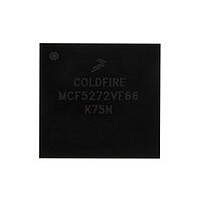MCF5272VF66 Freescale, MCF5272VF66 Datasheet - Page 291

MCF5272VF66
Manufacturer Part Number
MCF5272VF66
Description
Manufacturer
Freescale
Datasheet
1.MCF5272VF66.pdf
(544 pages)
Specifications of MCF5272VF66
Family Name
MCF5xxx
Device Core
ColdFire
Device Core Size
32b
Frequency (max)
66MHz
Instruction Set Architecture
RISC
Supply Voltage 1 (typ)
3.3V
Operating Temp Range
0C to 70C
Operating Temperature Classification
Commercial
Mounting
Surface Mount
Pin Count
196
Package Type
MA-BGA
Lead Free Status / RoHS Status
Not Compliant
Available stocks
Company
Part Number
Manufacturer
Quantity
Price
Company:
Part Number:
MCF5272VF66
Manufacturer:
HYNIX
Quantity:
19
Company:
Part Number:
MCF5272VF66
Manufacturer:
FREESCAL
Quantity:
885
Company:
Part Number:
MCF5272VF66
Manufacturer:
Freescale Semiconductor
Quantity:
10 000
Part Number:
MCF5272VF66
Manufacturer:
FREESCALE
Quantity:
20 000
Company:
Part Number:
MCF5272VF66J
Manufacturer:
Freescale
Quantity:
256
Company:
Part Number:
MCF5272VF66J
Manufacturer:
Freescale Semiconductor
Quantity:
10 000
Company:
Part Number:
MCF5272VF66R2
Manufacturer:
Freescale Semiconductor
Quantity:
10 000
Company:
Part Number:
MCF5272VF66R2J
Manufacturer:
Freescale Semiconductor
Quantity:
10 000
- Current page: 291 of 544
- Download datasheet (7Mb)
12.4.4.1
The data flow for control, bulk, and interrupt endpoints can be handled the same way for all 3 types of
endpoints. Control, bulk, and interrupt endpoints all support guaranteed data delivery. If the host detects
an error during the read of a packet from an IN endpoint, it requests that the packet be resent from the
device. The USB FIFO mechanism takes care of this without interrupting the CPU. In a similar fashion,
the USB FIFO mechanism keeps a received packet from being read by the user until the control logic
validates the packet for transmission errors.
12.4.4.1.1
The following example demonstrates how to transmit a transfer on an IN endpoint:
12.4.4.1.2
The following example demonstrates how to handle a received transfer on an OUT endpoint:
12.4.4.2
The data flow for isochronous endpoints must be handled differently than the data flow for
non-isochronous endpoints. Data on isochronous endpoints is generally streaming data. Therefore, there
is no concept of transfers and EOT. In addition, isochronous endpoints differ from other endpoint types in
two distinct ways. Isochronous endpoints support packet sizes up to 1023 bytes and isochronous packets
are never resent. In order to support the large packet sizes, the FIFO size can be less than two times the
Freescale Semiconductor
1. Wait until the last transfer is complete (an EOT interrupt has occurred).
2. Write data to the FIFO to fill it.
3. Wait for EOP interrupt or poll EOP bit.
4. Read EPnDP to determine the number of bytes that can be written to the FIFO. Normally, only one
5. Write data to the FIFO to fill it or until all of the data for the transfer has been written.
6. Repeat steps 5–7 until all of the data for the transfer has been written to the FIFO.
7. Clear EPnCTL[IN_DONE].
8. Wait for the EOT interrupt or poll the EOT bit. The user can now begin processing the next transfer.
1. Wait for the EOP interrupt or poll the EOP bit.
2. Read EPnDP to determine number of bytes in the FIFO.
3. Read the indicated number of bytes of data from the FIFO into a buffer.
4. Repeat steps 1–3 until EOT is set.
5. When EOT is set, the transfer is complete. While EOT is set, the FIFO is locked and any packets
6. Read EPnDP to determine the number of bytes in the FIFO if any for the last transfer. The EOT bit
7. Read the indicated number of bytes of data from the FIFO into a buffer.
8. The user can now process the received transfer.
packet should be written unless the software does not service the EOP immediately.
sent for the next transfer cause a NAK response.
can be cleared once this register has been read.
Control, Bulk, and Interrupt Endpoints
Isochronous Endpoints
IN Endpoints
OUT Endpoints
MCF5272 ColdFire
®
Integrated Microprocessor User’s Manual, Rev. 3
Universal Serial Bus (USB)
12-33
Related parts for MCF5272VF66
Image
Part Number
Description
Manufacturer
Datasheet
Request
R
Part Number:
Description:
Mcf5272 Coldfire Integrated Microprocessor User
Manufacturer:
Freescale Semiconductor, Inc
Datasheet:

Part Number:
Description:
MCF5272 Interrupt Service Routine for the Physical Layer Interface Controller
Manufacturer:
Freescale Semiconductor / Motorola
Datasheet:

Part Number:
Description:
TOWER ELEVATOR BOARDS HARDWARE
Manufacturer:
Freescale Semiconductor
Datasheet:

Part Number:
Description:
TOWER SERIAL I/O HARDWARE
Manufacturer:
Freescale Semiconductor
Datasheet:

Part Number:
Description:
LCD MODULE FOR TWR SYSTEM
Manufacturer:
Freescale Semiconductor
Datasheet:

Part Number:
Description:
DAUGHTER LCD WVGA I.MX51
Manufacturer:
Freescale Semiconductor
Datasheet:

Part Number:
Description:
TOWER SYSTEM BOARD MPC5125
Manufacturer:
Freescale Semiconductor
Datasheet:

Part Number:
Description:
KIT EVALUATION I.MX51
Manufacturer:
Freescale Semiconductor
Datasheet:

Part Number:
Description:
KIT DEVELOPMENT WINCE IMX25
Manufacturer:
Freescale Semiconductor
Datasheet:

Part Number:
Description:
TOWER SYSTEM KIT MPC5125
Manufacturer:
Freescale Semiconductor
Datasheet:

Part Number:
Description:
TOWER SYSTEM BOARD K40X256
Manufacturer:
Freescale Semiconductor
Datasheet:

Part Number:
Description:
TOWER SYSTEM KIT K40X256
Manufacturer:
Freescale Semiconductor
Datasheet:

Part Number:
Description:
Microcontrollers (MCU) MX28 PLATFORM DEV KIT
Manufacturer:
Freescale Semiconductor
Datasheet:

Part Number:
Description:
MCU, MPU & DSP Development Tools IAR KickStart Kit for Kinetis K60
Manufacturer:
Freescale Semiconductor
Datasheet:

Part Number:
Description:
24BIT HDMI MX535/08
Manufacturer:
Freescale Semiconductor
Datasheet:











